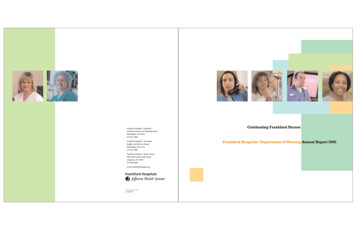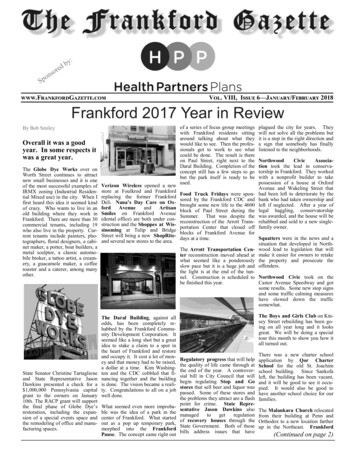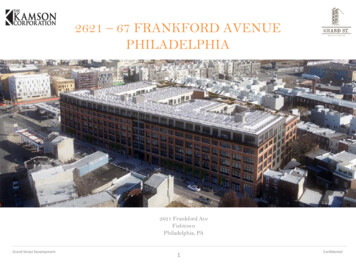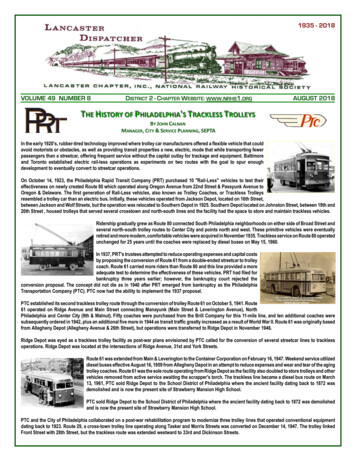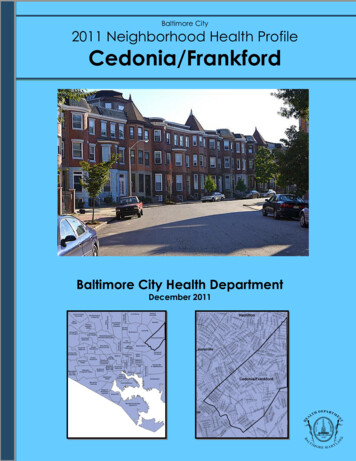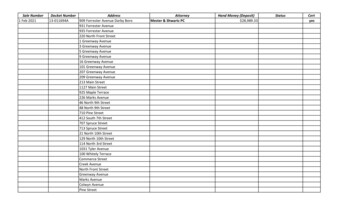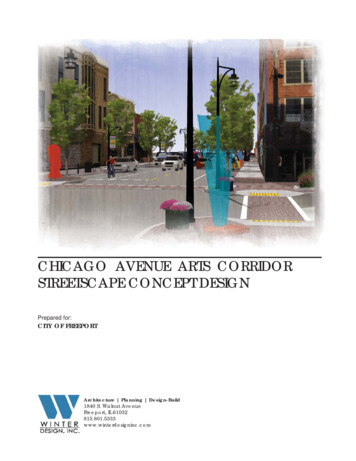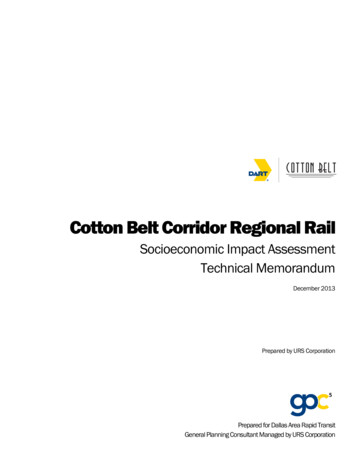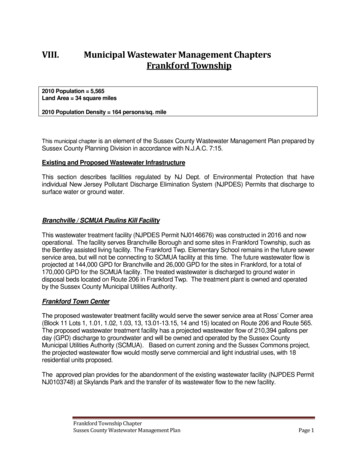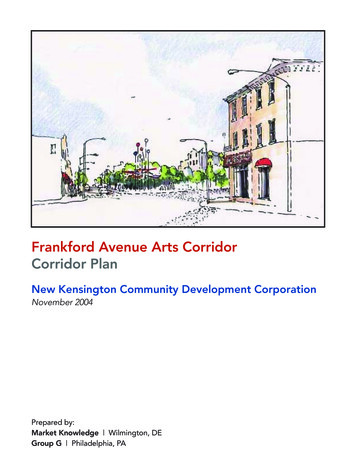
Transcription
Frankford Avenue Arts CorridorCorridor PlanNew Kensington Community Development CorporationNovember 2004Prepared by:Market Knowledge Wilmington, DEGroup G Philadelphia, PA
Trenton GatewayFrankford Avenue Arts CorridorArtwork and Greenspace
Palmer ParkFrankford Avenue Arts CorridorBike Racks and Bus Shelter
Trenton Avenue NorthFrankford Avenue Arts CorridorCommercial and Residential Revitalization
Executive SummaryNew Kensington Community Development Corporation (NKCDC) has created this comprehensiveplan for the development of the Frankford Avenue Arts Corridor. Built on Kensington’s history, currentassets, and changes occurring in the neighborhood, this plan outlines economic improvement, design,promotion and organization strategies that are key to making Frankford Avenue a vibrant arts corridor.Key improvements planned include the following:An Authentic PlaceParticipants in the public process insisted that Kensington’s working class nature bepreserved and enhanced.A Place for Artists to Live, Work and SellThe commercial corridor will become the commercial center of a community thatembraces the creative class. Artists will build equity in the corridor and become a keycommunity asset.Focus on Business ClustersAll economic improvement and promotion efforts will focus on creating clusters of fourtypes: Home Fixtures and Furnishings; Lawn and Garden Products and Services; SpecialtyFoods; and Film Production. These clusters will be strategically placed in one of threezones along the corridor.Focus on Customer GroupsClusters will focus on key customer groups, the groups most likely to buy those productsand services.Urban Design ImprovementsThe center of the district will be recreated to include a new green space and commercecenter that connects two neighborhoods currently divided by a wasteland and wall. Theimprovements will make the neighborhood more accessible to SEPTA riders.Concentrated, Phased DevelopmentDevelopment will be phased and focused in specific geographic areas.Streetscape ImprovementsThe corridor will be enhanced with street furniture, art, and trees. More importantly,property owners will have the opportunity to enhance their building facades to create aunique and welcoming district.Traffic and ParkingTrenton Avenue will be extended to meet Frankford Avenue to provide an alternate routeto the Berks SEPTA station and two new schools to be built in the area, and to provideample parking in the area.OrganizationThe tasks for this plan will be assigned to a working group convened by NKCDC thatdivides responsibilities and facilitates communication.Projects and FundingProjects will be implemented methodically with funding from a variety of sourcesincluding government, foundations and corporations.1 Corridor Plan Frankford Avenue Arts Corridor November 2004
IntroductionNKCDC has one goal for the Frankford Avenue commercial corridor (between Girard and LehighAvenues): to create a destination arts district. Through several informative meetings, NKCDC providedMarket Knowledge and Group G with the background needed to enable the team to identify thefollowing:History of the AreaKensington was the workshop of the world. At the heart of the industrial revolution, Kensington, atown established as a retreat from the urban life of Philadelphia, was a center of design, production andshipping. Key to this history was the trades people who lived, worked and produced here and the portsand rail systems that made commerce happen.1 Today, a group of artists and neighborhood residentsare reviving this heritage and building upon this firm foundation to again make Kensington a ‘workshopof the world.’ A longer discussion of the history of Kensington and its impact on the plan is included inAppendix I.Trends and Issues in the Frankford Avenue Arts CorridorThe Frankford Avenue commercial corridor is one of stark contrast. There are large, warehousebuildings juxtaposed against smaller 3-story row houses with first floor “mom and pop” stores. Thereare beautifully manicured, well-tended gardens and nearby trash-strewn vacant lots that break up thecontiguity of the corridor. There are whimsically painted benches for relaxing, but a person couldwalk blocks before finding one on which to sit. The area is well serviced by public transportation, butthere are no sheltered bus stops and the route to the elevated train station is universally consideredtreacherous. Newly renovated homes stand proudly next to deteriorating, boarded shells. In addition tothe physical contrast, there is the changing face of the neighborhood. Gentrification is making its imprinton the neighborhood with new homeowners, rising real estate values, and an eclectic mix of businessesopening on the corridor. Artists make up a significant portion of the new population, as rising center cityrents have pushed this group northward toward more affordable housing choices.Previous StudiesDrawing on the work of a previous study completed by Wallace Roberts & Todd, LLC (WRT) in 2002, thisstudy attempts to provide a more in-depth analysis for the establishment of an arts-centered commercialcorridor. The current neighborhood plan provides a backdrop of the overall health and vitality of thephysical components of the Kensington neighborhood, which enabled this study to look more closelyat some of the issues specifically facing the Frankford Avenue commercial corridor. In addition to theneighborhood plan, this study includes data from a visual survey of properties and infrastructure alongthe corridor. Throughout the planning process, several workshops were conducted with artist residents,business owners, and the broader community to gather information about the needs and desires of thecurrent population. These workshops focused on collecting information on existing conditions, as wellas brainstorming about how to use the Arts as an engine of economic opportunity and tool in creating aunique commercial district.Research Method: Neighborhood Business MarketMarket Knowledge studied both wants and needs of local residents and the buying habits of artspatrons. Research findings were used to come to specific conclusions and recommendations.To understand the neighborhood commercial corridor market, Market Knowledge conducted secondaryand primary research to identify complementary types of businesses for the corridor, and which productsand services neighborhood residents wanted. Secondary research included a demographic analysis, salesleakage analysis and research on other successful commercial corridors.The majority of customers who buy from a neighborhood commercial district come from householdssurrounding the area. This area includes the primary market (from which the commercial corridor couldNovember 2004 Frankford Avenue Arts Corridor Corridor Plan 2
optimally capture 60-80% of disposable income). See the map of the primary market in Appendix VII.Other potential customer groups considered include the working population in the neighborhood, thosepassing through the neighborhood (via car and transit), and visitors.Secondary Research: Demographic ShiftsTo understand these groups, Market Knowledge gathered research from the U.S. Censusand other sources. A summary of findings is included in the section on demographics.Primary ResearchMarket Knowledge and Group G conducted focus groups to understand whatneighborhood residents and artists want from the commercial corridor. The findings fromthe four meetings are summarized throughout this report.Organization of Remaining ReportThe market and urban design analyses of the Frankford Arts Commercial Corridor are presented in thefollowing order:Market AnalysisThe market issues we will examine include: Customers Competitors Commercial Corridor Assets Channel PartnersEconomic Improvement RecommendationsFrom these findings, we will suggest improvements that will enable NKCDC to takeadvantage of economic opportunities and improve quality of life for neighborhoodresidents. The recommendations will be strategies with the following elements: Products Places Price Points PromotionsPromotion RecommendationsThis Economic Improvement Recommendation is presented in greater detail. The reportprovides successful marketing tools borrowed from other communities and industries. Itprovides detailed instructions for cultivating specific customer groups.Image AnalysisThis report will examine the area’s image from the consulting team’s professional appraisaland the perspective of neighborhood residents. We will evaluate Frankford Avenue’surban design, streetscape, traffic and parking, and private spaces.Image Improvement RecommendationsBased on the market and image analyses findings, the consulting team makesrecommendations for improving the streetscape, traffic and parking, and urban design.Projects, Funding & OrganizationThe report concludes with a summary of recommended projects, costs, funding sourcesand organization.3 Corridor Plan Frankford Avenue Arts Corridor November 2004
Market AnalysisCommercial Corridor Assets: Kensington Avenue Arts DistrictThe commercial corridor’s assets – its buildings, businesses, and public spaces – are the things that makethe district unique and thus able to make money. Ideally, the corridor’s buildings will be fully utilized,merchants’ sales will be sufficiently vibrant at 150 or more per square foot, and your public assetswill create a special place where neighbors and shoppers want to go to and spend time. Realistically,the area’s building space is underutilized, businesses need to improve sales, and public assets needreinvestment. Market Knowledge inventoried the buildings and businesses, entered them into adatabase (which was delivered with this report), and identified business and development opportunities.BuildingsThe Frankford Arts Commercial Corridor is 13 blocks long. A summary of the corridor’sbuildings can be found in Appendix II. It has 376 deeded properties zoned as follows: 39% commercial, 14% industrial, 8% light industrial, 39% residential.Market Knowledge estimates that approximately 15% of the square footage of the firstfloor of these buildings is vacant. Many of the commercial spaces are being used asresidences or are vacant, and many of the industrial (including light industrial) spaces arevacant. It was difficult to tell whether the residential properties were occupied. NKCDCwill soon contactBusinessesWhen we asked the community and local artists to identify key businesses and clusters,they found it difficult to name key businesses other than the U.S. Post Office. They dididentify clusters they would like to build:Furniture and home fixtures Entertainment Graphic design Jewelers Clothing and accessories Construction Artists Suppliesand Support Food Performing ArtsDespite the community’s difficulty in identifying them, there are specialized artsbusinesses on Frankford Avenue. A summary of the mix of businesses is included inAppendix III. From this information, we identified the following clusters: Home Fixtures, Furnishings & Services Welding, Furniture Refinishing Specialty Food – Yard’s Brewery, Furfaris Pretzels. Auto Enhancement, Restoration & Performance ImprovementNovember 2004 Frankford Avenue Arts Corridor Corridor Plan 4
Public AssetsPublic assets can play an important role in creating a community in which people want to live, visit, spendtime, and spend money.Garden centerGardening classes and sales are conducted here. It communicates community in its purestform. This program, established by NKCDC, has played a catalytic role in revitalizing theneighborhood.Palmer ParkThis beautiful park is an oasis in a dense, industrial urban neighborhood. It is the heart ofthe community. It is a recruiting tool; use it as such.Elevated trainThe Market-Frankford elevated train brings thousands of customers by the communityeach day. The station’s potential has not yet been optimized.MuralsKensington and Frankford Avenue are blessed with large canvases of artwork thatprovides interest and beauty.Sculpture GardenFranco Karlie’s sculpture garden on Frankford just above Girard Avenue is an excellentexample of how art can be displayed along Frankford Avenue, especially on vacant lots.Upon closer examination, the zoning and use of the properties along the corrior can be divided intothree subdistricts, based on zoning and inspection. These subdistricts are defined as follows:Subdistrict I – Girard Avenue to Palmer Street The buildings have similar zoning (industrial) andcomplementary businesses (metalwork)Subdistrict II – Palmer Street to York Street This area also seems to be a natural heart of the ‘new’ community that isdeveloping due to gentrification. It has a nice a mix of commercial density and open space. It is close to the Berks and York-Dauphin elevated train stops. The zoning designations of the area will allow a diversity of businesses. The majority of buildings are in good condition and contiguous. Revitalization is already starting to work here. There are a few blocks at the north end of this subdistrict that have a densityand intimacy that is ideal for shopping.Subdistrict III – York Street to Lehigh Street Like the previous district, this district physically hangs together. York andLehigh Streets are natural boundaries for the this area; thus they create asubdistrict. There are several large properties here. Most properties arezoned residential. All the sidewalks in this district are in bad condition. Many properties are slated for demolition. The disruption that this causeswill make the area difficult to revive until greater revitalization momentum isevident. Nothing ties the businesses together. There are no complementary clusters.5 Corridor Plan Frankford Avenue Arts Corridor November 2004
Nearby Development ProjectsEven as the residential real estate market is growing, there are various new and potential developmentsthat are positively affecting the vitality of the commercial corridor. Several new businesses recentlyopened on Frankford Avenue that have revived sections of the commercial corridor. The Rocket CatCafé, a funky new coffee/sandwich shop, is a popular morning destination on the northeast corner ofFrankford Avenue and Norris Street. A few doors north on Frankford Avenue is Circle Thrift, a greatplace to find bargains on used clothing, home furnishings, and accessories. On the same block is theoffice for Positive Space, a consortium of local artists whose mission is to provide resources for artistsas well as integrating art into the local physical landscape through the transformation of vacant lots andbuildings. Across from Rocket Cat Café, planning is presently underway for Kenbo’s Barbecue, the firstnew sit-down restaurant in the area in many years. On a larger scale, the School District of Philadelphiais currently considering a large tract of land just West of Frankford Avenue and directly adjacent tothe Shissler Community Center as a location for two new schools in the near future. This site is alsoconveniently located near the newly renovated SEPTA Elevated Train stop at Berks Street. NeumannMedical Center will soon be converted into residential housing for senior citizens.CompetitorsNKCDC must consider the strength and competitiveness of the neighborhood-based and arts-focusedshopping districts with which Frankford Avenue will compete.Neighborhood-Based Shopping DistrictsThe community and artists identified the following neighborhood shopping districtsas places where neighborhood residents buy groceries, household supplies and othernecessities: Aramingo Avenue Port Richmond Village Delaware Avenue SouthAll three of these centers are easy to access, provide ample parking, and have nationalretailers that have broad product lines, competitive prices, long business hours, andsubstantial marketing budgets. Competing with them directly would be difficult. Indeveloping a new neighborhood commercial center, NKCDC should consider thefollowing to compete more effectively: Recruit stores that sell products and services most needed in the community. Try not to compete with the strong businesses in the closest centers,especially the chains. They have deep pockets and compete more effectively. Add parking wherever possible. Place near public transportation hubs, especially near elevated train stationsand major bus transfer points, to make the project more attractive todevelopers. Use building and landscape design to make the center a place people want tospend time. Buffering green space, flowers, and sculptured outdoor furniturecan make a neighborhood center more like a park and encourage people tospend time and consequently spend money.November 2004 Frankford Avenue Arts Corridor Corridor Plan 6
Arts-Focused Commercial CorridorsUsing the arts and artists as an economic revitalization catalyst is a commonly usedstrategy. Several other communities in Philadelphia are employing this strategy. Thus,NKCDC must realize that they will compete to attract artists and arts patrons. Artistswho attended one or both of the public meetings identified Girard Avenue, Manayunk,Northern Liberties, Cape May (NJ), Haddonfield (NJ), New Hope (PA), Bella Vista(Philadelphia), and Peddler’s Village (PA) as competitors to their arts corridor strategy.Two particularly good examples of arts-focused commercial corridor initiatives are inPittsburgh. The Penn Avenue Arts Initiative www.pennavenuearts.org is a verysuccessful arts corridor initiative organized by two community developmentorganizations in the Bloomfield and Garfield communities in Pittsburgh. Theseorganizations with the cooperation of artists have helped artists acquire andredevelop commercial property along Penn Avenue and create a destinationcommercial corridor. 1662 Design Zone www.1662designzone.com, Pittsburgh’s interior designand decorating district. A group of artists and craftsmen are methodicallytransforming this working class community into the place to acquire highlydesigned and well–constructed home fixtures and furnishings. The 1662Design Zone (Butler Street between the 16th and 62nd Street bridgesjust outside downtown Pittsburgh) supports its artists with targeted print(brochure) and electronic (web) media. Urban design (complementary façadeimprovements that respect architectural integrity) orients shoppers and givesdirection through small decorative banners.Each of these communities has something to teach NKCDC about using arts as aneconomic revitalization catalyst. These include the following: Get properties into the hands of owners who can make the properties useful. Preserve the unique character of the commercial corridor. Showcase uniquearchitectural features, keep buildings contiguous, open front windows so thatshoppers can see all the way into the back of the store, and make the façadesnoticeable and attractive. Help merchants become good business owners. Teach them marketing, goodretail practices, and financing. Transform the public and private spaces into places in which people want tospend time. Use creative design to encourage shoppers to stroll down thestreet, let them know they are somewhere special, guide them to interestingareas, and give them rest, relaxation and renewal. Create events that define the character of the neighborhood. Organizespecial events that create lasting memories.7 Corridor Plan Frankford Avenue Arts Corridor November 2004
Competing with Other DistrictsTo compete effectively – even harmoniously – with the other commercial corridors,NKCDC should do the following: Study their design: what features of their public and private spaces makethem unique and memorable? What makes shoppers want to stay? Study their business mix: how does the mix work to make the commercialcorridor unique and attract customers? Examine the retailers’ and galleries’ supplies: what artists are selling there?These may be artists you can attract to the commercial corridor. Figure out their marketing strategies: how are they drawing customers to thecommercial corridor? Are they trying to attract one specific customer group?On what days and times do they want customers to shop? Identify their channel partners: what organizations are their partners? Howare they partnering to attract and better serve artists and shoppers?Customers: Neighborhood Residents & Arts PatronsBecause focus group members wanted a commercial corridor that appealed to both neighborhoodresidents and arts patrons, Market Knowledge gathered and analyzed demographic and buyerinformation about neighborhood residents and arts patrons.Kensington Arts Center DistrictPrimary MarketAgeAll AgesRaceOne RaceWhiteBlack or African AmericanAmerican Indian and Alaska NativeAsian or Pacific IslanderSome other raceTwo or More RacesEthnicityLatinoHouseholdTotal householdsEducational AttainmentPercent high school graduate or higherPercent bachelor’s degree or higherHousehold IncomeMedian household income (dollars)% HHs with Lower Income ( 25,000)% HHs with Middle Income ( 25,000 to 74,999)% HHs with Upper Income ( 75,000 ) 1990101,433200093,933% %18,81962%36%2% November 2004 Frankford Avenue Arts Corridor Corridor Plan 8
Demographic ChangesThe aggregate changes in demographics (seen in the table above) in the 1990s, considered in isolation,were not positive. A closer inspection of the specific census tracts showed very positive changes:repopulation and rising incomes and education levels. Here are some of the changes we found:Changes in the aggregate market.a. More than a third of the population left the neighborhood in the 1990s.b. Fewer residents are obtaining high school diplomas – only two in fiveresidents had obtained high school diplomasc. Median household income rose substantially and more households can beconsidered having moderate incomes.Changes due to gentrification.a. Specific census tracts experienced substantial repopulation in the 1990s: 126,127, 128, 129, 130 & 143 (Old City & Northern Liberties).b. The neighborhood is becoming more diverse. Whites are still the largestpopulation but the neighborhood is becoming home to more AfricanAmericans, Hispanics and Asians.c. Each of the aforementioned census tracts also experienced rises in educationattainment and household income.d. The majority of new residents are non-related (perhaps single) households.e. There is evidence that gentrification is spreading northward into Kensington.i. Property values rising: anecdotal stories from long-time and newresidents tell us that property values are rising rapidly. This is goodbecause poorly maintained properties can get sufficient capitalizationto make the properties useful.ii. Development projects: residential and commercial projects, suchas the Yards Brewery relocation from Manayunk – are validating thevalue and opportunity in Kensington.f. Interviews with Realtors: real estate professionals tell us that properties are selling fastfor sums larger than asking prices.Changes in the balance of supply and demand.Due to changes in demographics and the local business climate, Market Knowledgeconducted a sales leakage analysis (to estimate the difference between demand andsupply)2.We also identified the following business opportunities (by sales and square footopportunity);Medical supplies 1.7 million11,235 square feetSports Equip/Supplies 0.5 million3,702 square feetChildren’s Apparel 10.4 million69.053 square feetWomen’s Apparel 10.6 million71,879 square feetGas and Oil 28.3 million188,758 square feetHousehold Textiles 3.6 million37,965 square feetHousekeeping Supplies 6.8 million45,554 square feetThe complete sales leakage analysis is included in Appendix IV.9 Corridor Plan Frankford Avenue Arts Corridor November 2004
Art CustomersArt collectors are the lifeblood of an artist’s business – and the lifeblood of an arts district. NewKensington Community Development Corporation (NKCDC) must understand them in order to create aviable arts-based economy. To better understand collectors and other persons likely to purchase artwork,Market Knowledge conducted secondary and primary research. We interviewed gallery owners andanalyzed regional demographics. They helped us develop an appropriate marketing strategy for the artsdistrict as a whole and the home fixtures and furnishings cluster in particular.3Gallery Owner’s PerspectiveMarket Knowledge interviewed two well-respected gallery owners, one in Wilmingtonand another in Philadelphia, to better understand how the artwork value chain works.Both said they understood the challenges of artists wanting to show and sell their work.From their multiple years in selling art, these gallery owners said that the followingguidelines may help NKCDC choose which artists to attract to the commercial corridor: Names are ImportantArtwork can be difficult to sell if not the artist is not known. Without a notablename, it will be difficult to sell at all or for a respectable price. Attracting afew well-known artists to Kensington can validate and catalyze the growth ofthe arts district. Good Art SellsWhile art is very subjective, customers prefer to purchase high quality art.Most people do not purchase art that includes themes outside of their ethnicgroup. While the arts corridor should offer a diversity of styles and prices,high-end art should be well represented on the corridor. Sometimes namematters, but often style matters most. NKCDC should have a way to find andattract good artists. Niches MatterNot all art collectors are alike, according to gallery owners. There are largeniches of different types of collectors. For example, one collector shared thathe has a small and very loyal group of African-American and Latino executiveswho seek unique prints and other original artwork. He is regularly looking forunique artwork for those clients. Understanding gallery owners’ needs andcreating and promoting specific client niches can focus commercial corridordevelopment efforts.Best CustomerFrom the Consumer Expenditures Survey (CEX) – a bi-annual study of American buyinghabits conducted by the federal government, we know that the best customers4 for artstudios and other businesses that sell decorative items for the home can be described asfollows: Married couples without children. Married couples with adult children. Have median households of 40,000 or greater – their likelihood of purchasingprints rises dramatically when median household income rises above 70,000 Ages 45 to 54 (at the height of their career and earning potential) and 65 to74 (free of fixed costs and seeking luxury)November 2004 Frankford Avenue Arts Corridor Corridor Plan 10
Spend an annual average of 134.12 on decorative items for the home. Thisaverage does not mean that all families spend 134.12 on home décor items– some do and other do not. As mentioned, the better customers are middleaged, most likely highly educated, married, have no kids or their children aregrown, and earn respectable incomes. Finding these customers – and channelpartners who have relationships with them – is key to effectively marketingand selling prints.Luckily, NKCDC has two key trends on its side: demographics and the Philadelphia suburbs. Allstakeholders in this revitalization effort must capitalize on these trends. General demographics are perfect for art sellers. Baby boomers are currentlyin the 45-54 age group and heading towards retirement. That means thatthey are at their highest earning potential and are most willing and able topurchase unique items. This market will grow as middle-aged empty nestersgrow in numbers. The Philadelphia suburban counties are some of the most lucrative marketsfor home fixtures and furnishings businesses5. If there are 2 millionhouseholds in metropolitan Philadelphia, that translates into nearly 268million spent annually on home décor items. Getting just a small portion ofthis market can be profitable for artists. Market penetration in Philadelphiaand other diverse markets is key to its success.Image AnalysisStreetscapeNeighborhood amenities along the corridor, such as bicycle racks, benches, sheltered bus stops,and trashcans are severely lacking. Survey of Frankford Avenue reveals there to be only two bicycleracks and public trashcans and no sheltered bus stops along the entire commercial corridor. Lack of suchpublic amenities may contribute to the amount of trash along the Avenue and the overall deterioration ofneighborhood living conditions. In addition, community residents have expressed a strong desire to havebike racks installed along the corridor in order to facilitate the use of bicycles as means of transportationwithin the neighborhood. See Map A.Sidewalk conditions along several sections of the corridor are treacherous for pedestrian trafficto navigate. Although several sections of sidewalk along Frankford Avenue have been recentlyimproved, there remain numerous areas on both the eastern and western sides that are in immediateneed of maintenance. Commercial and recreational activities are particularly disrupted by the conditionof sidewalks between Norris and Lehigh Avenues as residents are unable circulate throughout theneighborhood without being forced to walk in the street or over stretches of crumbling concrete. Thereare also several sections of sidewalk that need to be replaced in the area between Columbia and Girard.See Map B.Lack of street trees creates a bleak image of an unfriendly Frankford Avenue. There are few treesalong the entire length of Frankford Avenue to offer a cool and shaded respite in the summer andprovide the welcoming signs of new seasonal growth and health long associated with greenery. SeeMap C.The scale and graceful curve of Fra
The Frankford Arts Commercial Corridor is 13 blocks long. A summary of the corridor's buildings can be found in Appendix II. It has 376 deeded properties zoned as follows: 39% commercial, 14% industrial, 8% light industrial, 39% residential.
